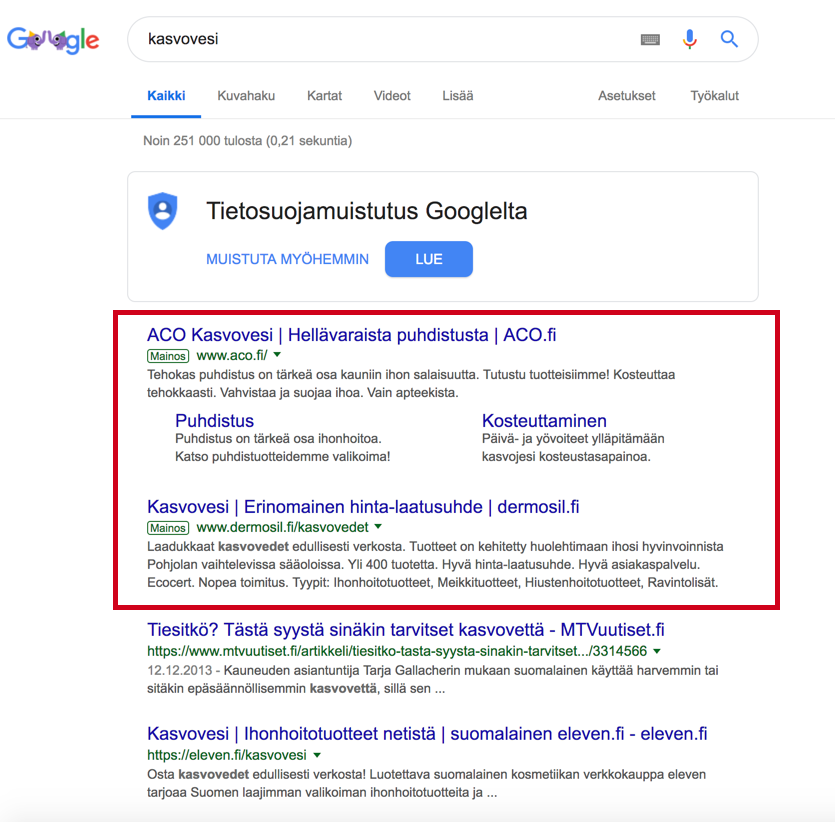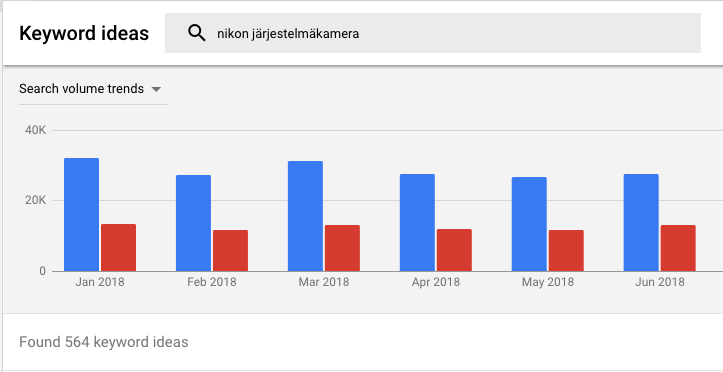Search engine marketing is extremely effective marketing. The reason for this is that through search engines, you can reach an audience that is very close to making a purchase. With search engine marketing, a company can showcase its products or services in this critical phase of the buying journey.
Let's explore the secrets of effective search engine marketing in this article.
What is search engine marketing?
Search engine marketing consists of two different marketing tactics: search engine advertising and search engine optimization. The majority of Finns use Google as their search engine, so most of the investments in search engine marketing are directed towards Google.
Search engine advertising refers to the ads displayed in search engines. Ads are triggered by selected keywords, and advertisers pay a cost-per-click fee. Below is an example of our own Google ad:

However, not all ads appear in every search. Their appearance is determined by a real-time auction. Companies advertising on Google compete in this auction - the ad with the highest Ad Rank (Google's scoring system) "wins" the auction and gets displayed first. In Finland, there are 30 million Google searches made every day, so even the "Auction Kings" wouldn't have time to manage all these auctions; it's Google's algorithms that oversee the transactions.
Depending on the competition, 0-7 ads can appear simultaneously on one search result page. Below is an example of a search for "facial toner," where two different ads have been selected for the top positions on the page:

Search ads are identified by the text "ad" next to them.
Search engine optimization, on the other hand, refers to the techniques used to elevate a website to the top of Google's natural search results through various technical measures. In the example of facial toner, natural search results appear as follows: published
Natural search results are shown below the search ads. One of the advantages over search advertising is cost: there are no separate fees to Google for natural search results, so all traffic obtained this way is free. Additionally, people tend to trust natural search results more. However, search engine optimization requires a long-term strategy, as achieving a spot among the top search results usually takes at least 6-12 months of waiting and hard work.
I claimed at the beginning of the article that search engine marketing is particularly effective marketing. Let's take a closer look at the specific reasons for this effectiveness.
Reaching a Ready-to-Buy Audience from Search Engines
People typically go through some kind of decision-making process before making a purchase. The complexity and length of this process depend on factors like the person's commitment and interest in the purchase, as well as the price of the item.
For example, most food purchases are made out of habit without much thought (unless the buyer has a food allergy, which requires more planning and research). On the other hand, buying a house ties up a significant amount of capital, so most people thoroughly research before making the decision.
The decision-making process can include the following stages:
Identifying the need
Gathering information
Comparing options
Making the purchase decision
Post-purchase behavior
A passionate photographer might feel the need to upgrade their equipment. This need may arise internally, but it could also be prompted by factors like advertising or a friend's new camera purchase.
The information gathering phase often starts with a Google search. Googling expands knowledge on the topic (e.g., "What is a suitable F-number for a camera? How does lens stabilization work and is it necessary?") and explores the available options in the market.
In this case, a photography enthusiast might already know the best camera models on the market, so they quickly move on to the third phase, which is comparing options. This phase is also facilitated by Google, as the person compares the features of different cameras, reads user reviews, and delves into reviews by industry experts.
Once a suitable option is found, the enthusiast makes the final decision and purchases the camera. A price-conscious buyer might still search for prices from different stores at this stage and opt for the cheapest option (provided the store is otherwise trustworthy).
This is why search engine marketing is particularly effective: it puts the company's products and brand in front of consumers in the most critical phase of the buying process.
How to Start Search Engine Marketing?
It's advisable to start with search engine advertising. Why? Because this way, you'll quickly see the effectiveness of search engine marketing. The only major difference between ads and natural search results is the "ad" text next to the ads (as shown in the earlier image), so both techniques target the same audience.
However, with search advertising, visitors start coming to your website as soon as the ad campaign is launched and the ads appear on Google. Search engine optimization takes at least several months before results start showing, as the first page of Google search results gathers almost all the traffic, and reaching this top page requires more than just pressing a publish button. Having seen the effectiveness of advertising in practice makes it easier to stick to the strategy.
Let's now delve into the specifics of search advertising.
Search Advertising is Suitable for Direct Conversion
When creating a search advertising campaign, the first step is to conduct keyword analysis. In keyword analysis, you're looking for keywords you want your ads to appear for. Understanding the searcher's intent is crucial. Why is the person using that particular keyword? Are they looking to make a purchase, or are they seeking general information on the topic?
Google's Keyword Planner allows you to explore the keywords people use when searching on Google. You enter the desired keyword, and it shows related searches along with their average monthly search volumes.
By entering "Nikon DSLR camera," Google provides a total of 564 keyword ideas. These include, for example:
Nikon D3100 price
Used Nikon D500
Photography

For a searcher using the keyword "Nikon D3100 price" the incentive is quite clear: the searcher is interested in that particular camera and is now researching its price. This person is often in the information-gathering or comparison phase of the buying process. With search engine marketing, a retailer selling Nikon DSLR cameras could get their business in front of potential customers at this crucial stage and potentially acquire a new customer - if the price is right and other conditions of the purchase are met.
On the other hand, "Used Nikon D500" is a keyword that a retailer selling new DSLR cameras might want to include in their list of negative keywords. Advertising with this keyword may not be profitable because the product offered by the company does not meet the searcher's needs. People tend to click on the first search results, so the website might receive traffic, but the conversion rate would likely be low.
The above example also illustrates why conducting keyword analysis is such a crucial part of search engine marketing. The campaign could be created with very broad settings, but in that case, ads would also appear for keywords where advertising may not be profitable. Most companies operate under budget constraints, so it's crucial to get the most value out of your advertising budget with a tightly optimized campaign.
"Photography" is clearly a more informational search, which might be used by someone considering starting a photography hobby. Whether to use this keyword in an advertising campaign depends largely on the company's budget: it's advisable to allocate the budget first to keywords with clearer purchase intent. Afterward, you can explore opportunities with broader matching keywords.
Due to budget constraints, keywords that fall outside the scope of the advertising campaign can still be utilized effectively in search engine optimization. Let's delve into this next.
Search Engine Optimization for Diverse Traffic
The technical implementation of search engine optimization is carried out through internal and external optimization. Internal optimization involves adjusting the website's structure, meta-information, and content to be search engine-friendly. External optimization, on the other hand, involves acquiring links from other websites to the company's website.
Search engine optimization can be used to acquire traffic in various stages of the buying process, as well as to create general awareness.
To acquire traffic in the stages of the buying process, content can be optimized with similar keywords as those used in the search advertising campaign. Ideally, the company's ad and natural search result would both be visible on the first page of Google.
One advantage of search engine optimization over search advertising is that it doesn't involve paying separate cost-per-click fees to Google. This means it can also be used to acquire traffic aimed at creating awareness, which might not be cost-effective through search advertising alone.
Content can be optimized through both content pages and blog articles.
Optimizing Content Pages
Content directly related to the company's products and services is a good place to start with search engine optimization. Content pages in this context refer to pages that present the company's services and products, such as the homepage, service page, and product pages in online stores.
In an online store, a natural way to start search engine optimization is to optimize the textual content of product and category pages. For example, a camera retailer could optimize the category page for Nikon DSLR cameras with the keyword "Nikon DSLR camera" and the specific product pages for those models (e.g., "Nikon D3100").
A service-oriented company can optimize the more detailed pages that present the services with keywords related to those services. However, there are limitations to optimizing content pages. While having as comprehensive content as possible is good for search engine visibility, on service pages, too much detail might make the page confusing and thereby reduce conversions. This is why in search engine marketing, it's also advisable to utilize blog articles.
Optimizing Blog Articles
Blog articles can showcase a company's expertise through high-quality writing.
For instance, a camera retailer could create a camera comparison that could be optimized with the keyword "DSLR camera comparison." This way, traffic in the information-gathering and comparison phases of the buying process can be acquired through search engine optimization.
As mentioned earlier, "photography" is too broad a keyword to use in a search advertising campaign, but through search engine optimization, it can be used effectively. However, this keyword has so much competition that it's worth investigating more thoroughly and looking for better opportunities in longer-tail keywords or other keywords related to the topic.
A comprehensive guide could be written on the subject, presenting photography as a hobby and explaining technical aspects of cameras that every photographer should know. High-quality writing aims to expose readers to the company's brand and create a positive brand image.
In Conclusion
Search engine marketing is particularly effective marketing because it allows you to reach consumers in the midst of the decision-making process. It's recommended to start with search advertising, as this allows you to quickly see results and evaluate the suitability of marketing for your business. After a successful search advertising campaign, it's easier to commit to the long-term strategy required for search engine optimization.



